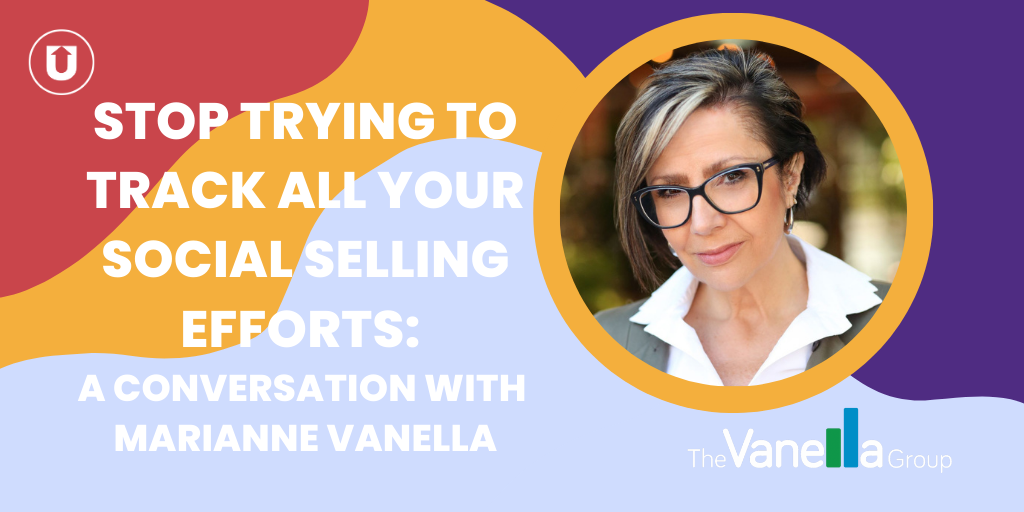Stop Trying To Track All Your Social Selling Efforts
 Are you spending time trying to justify your social media activity by attempting to measure and track each and every effort to a conversion?
Are you spending time trying to justify your social media activity by attempting to measure and track each and every effort to a conversion?
Whether you’re a sales rep, financial advisor, CMO, or digital content marketer, you’ve probably tried to figure out ways to prove that your social selling strategy is working via more demos, deals closed, or sales made.
But we hate to break it to you…tracking social selling doesn’t work like that.
The basic premise of using social media in your sales process and “social selling” as a practice is building a relationship with prospects through impressions, valuable content, and interacting in a digital world the way you would in real life.
Here at UpContent, we’ve been helping thousands of people and hundreds of businesses with their social selling strategies using curated content and even providing tracking tools to help make decisions about their content mix.
You can easily track impressions, engagement, and clicks, but that’s only one slice of the sales pie.
We sat down with sales development specialist MariAnne Vanella, Founder and CEO of the Vanella Group, Inc. to ask her what tracking, if any, she has implemented with content curation and social selling efforts, and she told us three things that we’d cover in this article:
- There’s not a measurable and accurate way to track your efforts in B2B enterprise sales where there is a direct line from posts to a conversion; (this isn’t talking about LinkedIn ads or very targeted efforts, just basic sharing content in your feed.)
- If you are trying to track these efforts to see ROI, you’ll be disappointed, and
- It’s being discoverable, sharing trusted content, demonstrating experience, and engaging that is important.
There’s Just No Good Way To Track with Large Deals
“I don’t track sales made through social media because there’s not really a good way to attribute engagement to closes with the type of work we do,” MariAnne replied when we asked her if she has been tracking the results of her curation strategy.
“When people come to us, they might look at the site, search on us and click on content, they might sit on that for a while and then find us on LinkedIn or Twitter, or even articles on other platforms, and all of it combined builds to that tipping point to reach out to us.
It’s all of it combined vs. how much did our Twitter posts generate in bottom line revenue.”
“When I share curated content, I will look at the topics that get engagement. I’ll go look at my social analytics, see who engaged with what, and then I might reshare the ones that did well,” she says.
But she doesn’t try to connect that engagement to sales because there isn’t a simple, linear funnel.
If anything, that’s a myth created by sales and marketing professionals based on the idea that marketing efforts will toss leads into the sales funnel that a sales rep will handle from start to close.
But nowadays, most of that funnel is more like Plinko (any Price is Right fans around here?), with prospects working their way through the sales process on their own journey in the digital space, sometimes never even talking with a sales rep until later stages after engaging with content on numerous platforms.
So without a linear process to track, what’s a better way to approach proving social selling works?
If You’re Trying To Track Deals From Social Media, You’re Going To Be Disappointed
“I think this is what happens with a lot of companies. They’re looking to measure that and track curated content and other social selling strategies, but they’re going to be disappointed,” MariAnne says.
Because the sales process isn’t linear, your tracking can’t be linear, either.
But that doesn’t mean social media, curated content, and thought leadership aren’t valuable to your bottom line.
In fact, it’s essential to your bottom line, according to MariAnne.
She says it’s about being active and establishing thought leadership in your space, whether through social media sites like LinkedIn or Twitter, email newsletters, or even 1:1 emails with prospects in your funnel.
“There’s a lot of different things that I do, like creating original and curated third-party content, that isn’t necessarily measurable, but rather valuable.
Some of the articles I’ve written have a significant shelf life as well as other articles and content I have shared, and those are valuable to my audience.
I know it’s important for my personal and company’s brand to help other people and to help my customers,” MariAnne says.
She says she has seen many marketing organizations trying to track if they have closed a deal because of their Twitter activity, but the reality is: it is unlikely that will be what they see when they look at their customer journey.
Then those same companies backpedal on any social selling efforts they did have and do less.
“They’re like, ‘We don’t want to spend money on that because we’re not closing deals with [insert social selling programs, software, etc.].’ First, [social selling] is so cheap. And the time is so little. So why throw out the baby with the bathwater, right?
Just do it and stay out there, and you are putting yourself in a position to be seen,” she explains.
Trust You Are Discoverable
How can you prove that your social selling efforts are actually helping you close deals?
Can prospects find you? What do they find? Does it set you apart?
So much of sales is building trust with your prospects and keeping your name top of mind for them.
Nowadays, you have to do that through valuable, thought leadership content. Be the expert they can trust, and stay in front of them, so they remember to come to you for help.
“Every time you share something valuable with your prospects, you leave an imprint of something positive. You’re putting your name in front of them again, and it’s showing that you’re interested and engaged with their industry,” she says.
Nobody likes to be sold to, especially now with so many bad sales calls prospects get, but using curated content can help you build credibility and thought leadership without being only about the direct impact on your bottom line.
MariAnne says she sees many large companies that sell solutions over $1M, but 75% of their content is all “Buy our stuff” oriented.
For example, a call to action for a demo, product information, and sales-oriented content.
Everyone knows you will give them a demo or have a sales call with them, you don’t need to ask that and waste real estate in your prospect’s feed with that.
Rather share something that they can use and remember.
“You’re showing yourself to be more of a resource to them than just trying to sell them something. So if you’re actively sharing credible third-party content relevant to them, you’re showing that you’re involved in that space, and you’re sharing knowledge and adding value,” MariAnne explains.
“Then you become more of an expert in their eyes. Even if you’re not tracking it too closely, those imprints make a difference.”
Use Curated Content To Increase Credibility
MariAnne says she has had people mention that they read an article she shared while on a call, but that’s not why she shares curated content.
“If I look up a rep or a company that is trying to sell me something and I see them sharing a lot of high-value curated content like research, a study, or analysis of a trend in their space, I’m going to have a different view of their knowledge than somebody that’s just like, ‘Hey, schedule a demo with me’” on every post, she says.
You’re not going to get large deals because you shared an Inc. article, a Fast Company article, or an HBR article, but what you’re going to get is impressions.
“Sharing curated content shows you want to educate and inform your followers and connection base and that you’re interested in what you do,” MariAnne says.
Marketing Efforts You Should Track
MariAnne says the tracking she does with curated content is to see what her followers are engaging with.
If a certain type of post or topic gets a lot of attention, she will look for more content like that to share or even use that as a springboard for her content creation efforts.
She also keeps in mind the time of day. Maybe one article got no engagement in the morning, but it blew up when it was shared in the afternoon.
Using the data you receive from impressions and engagement will help you see the pulse of your social selling strategy you need to better align with, but very rarely will you see a direct line to dollar signs.
“But content curation is not expensive, and you get a lot of payoff in visibility. But if you’re just looking at dollars, you’re not going to see them,” MariAnne says.
In fact, $15 a month can completely transform your social media marketing strategy using curated content.
If you’re interested in learning more about why you shouldn’t track every little detail in the marketing and how creating a content mix will help build credibility as a sales rep, talk to one of our Content Curation Experts today!
Or, if you’d like to read more about why you should have a content mix, check out these articles:
The Sales Secret To Stay In Front Of Your Prospects
5 Benefits of Using Curated Content on Twitter for Thought Leadership
Created Content vs. Curated Content: Which One Is Right For You?



